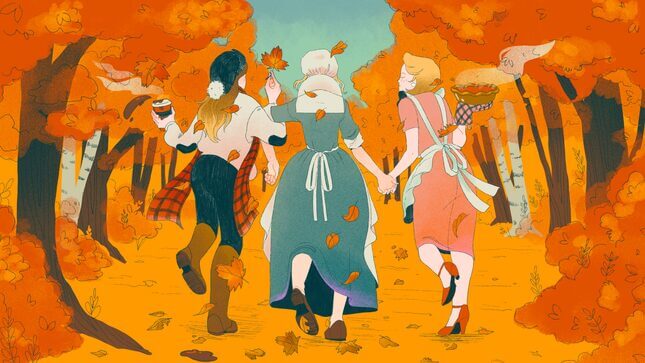
Illustration: Chelsea Beck
As the lush green trees of the Northeast begin to brown and a chill rolls through the now-darkened hours of the early morning, she appears every autumn, like Truth coming out of her well: the white girl who absolutely loves fall.
You know her even if you don’t know her: long hair tucked underneath a premature beanie, swimming in an oversized, off-the-shoulder cozy sweater, knee-high brown suede boots she’s been dying to break in all summer. Maybe she’s taking a selfie with a dreaded Starbucks Pumpkin Spice Latte, or staging a photo shoot at an apple orchard on a still sweltering October Saturday that she’ll perfect on VSCO hours later, accentuating all the right orange and red tones. She puts pumpkins at her doorstep the minute it’s socially acceptable, and she fills her home with a swirl of Yankee Candle scents like “Apple Spice” and “Harvest.” She is “basic,” and she is typically rendered as white.
For the past decade, the basic white girl who loves fall has become so solidified in the cultural imagination that she may as well be the season’s Easter Bunny. Internet memes from the fairly recent “Christian Girl Autumn” to the Pumpkin Spice-loving “basic bitch” discourse of the early 2010s—no matter how derisive—have only made her stronger. But her consistently meme’d existence has roots in American pop culture that extend far deeper than Starbucks orders, formed by decades of magazines, influencers, and entertainment that has connected traditional markers of the Northeastern fall experience with white femininity, bound by nostalgia for simpler times.
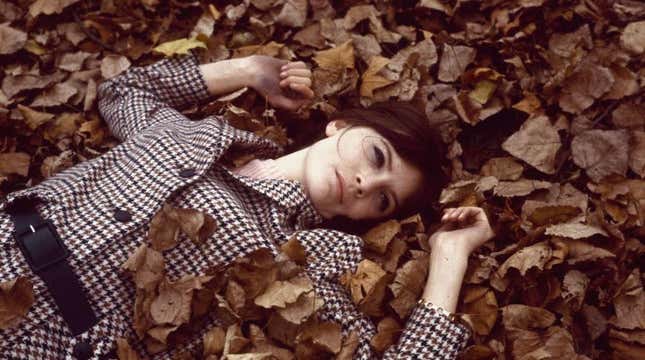
In America, the fall season conjures up twin feelings of nostalgia and clean slates simply for its connection to the academic calendar. If the crunch of autumn leaves and sweater weather makes you want to, as Joe Fox says in You’ve Got Mail, “buy school supplies,” it’s because of the strong “back to school” associations baked into your brain. But it’s also a season for the nation to collectively get nostalgic for its own beginnings. Thanksgiving, a holiday defined by whiteness, has been glamorized for more than a century for school children and white families alike.
As David. J Silverman writes in his book This Land Is Their Land: The Wampanoag Indians, Plymouth Colony, and the Troubled History of Thanksgiving, during the 18th and 19th century Thanksgiving was only a regional holiday and celebrated largely in New England. It had no actual link to Pilgrims and Native Americans and only gained that reputation after Reverend Alexander Young noted that a 1621 gathering between English Pilgrims was “the first Thanksgiving” in an 1841 book about the event. Plymouth then seized on the opportunity to celebrate the Pilgrims in a bid for tourism, cultivating the myth of a joyous and peaceful feast as opposed to what really happened, which is that the Wampanoag tribe settled there had already been displaced, murdered, and ravaged by plagues Europeans brought over.
By the late 19th century, Thanksgiving’s history—and by extension, the history of America’s founding—had been white-washed. The all-American, traditional Thanksgiving as we know it in 2020 was only adopted nationwide with the help of Sarah Josepha Hale, a novelist and enthusiastic white woman who was a proto-influencer for popularizing the holiday. Hale began lobbying in the late 19th century for the United States to make Thanksgiving a national holiday. Hale wrote about her family Thanksgivings growing up in her 1827 novel Northwood, in which she describes eating a big roasted turkey and pumpkin pie. But she also wrote about the importance of autumn and celebrating the holiday beyond the Pilgrim myth. One character in her book says, “autumn is the time when the overflowing garners of America call for this expression of joyful gratitude.”
Hale gained an even larger platform when she began editing the women’s magazine Godey’s Lady’s Book. “By the time Thanksgiving became a national holiday, Hale—and her popular magazine—had already planted the idea in women’s heads across the nation that this is something they would want to do,” Alice Roth wrote in a piece for Vice. Hale published editorial after editorial explaining how needed the official holiday was, emphasizing the idea that Thanksgiving would create a sense of unity during the Civil War. Eventually, her wish was granted by Abraham Lincoln in 1863, and Hale’s vision of Thanksgiving, a celebration to commemorate the bountiful harvest of fall that totally obscured the holiday’s violent roots, was solidified. Even after, Hale stressed how important the holiday was to women. “Should not the women of American have one festival in whose rejoicings they can fully participate?” she wrote in 1876.
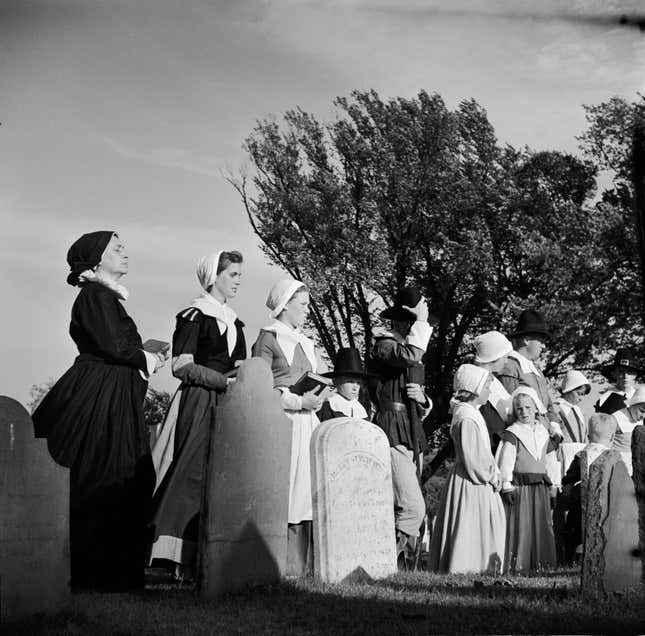
Into the 1900s, Thanksgiving’s importance as a time to celebrate domesticity and white, all-American nationalism would expand. As Elizabeth Pleck writes in “The Making of the Domestic Occasion: The History of Thanksgiving in the United States,” the 1924 Macy’s Day Parade and similar parades helped accelerate the commercialization of the holiday and its coronation as a “domestic occasion.” “The ideology of domesticity, the cultural and economic anxieties and dislocations of the industrial and commercial revolutions played a significant role,” Pleck writes. “Middle-class women found the idea of the domestic occasion an affirmation of their nurturing role in the family, and an opportunity for kin to reunite.” Thanksgiving was billed as an opportunity to assimilate immigrants into American tradition, but the holiday feast was still largely celebrated by the financially privileged, particularly those who could actually afford the shiny turkey centerpiece. Pleck notes that in 1900, Black families may have been going to church services for the holiday, but they weren’t partaking in the feast the way white families were, because they still saw Thanksgiving as a largely religious celebration.
When Franklin Delano Roosevelt moved Thanksgiving to an earlier date in 1939, he did so to accommodate retailers who were worried about consumers not having enough time to do holiday shopping. In Pumpkin: The Curious History of an American Icon, historian Cindy Ott writes that under Roosevelt, a new Thanksgiving motif emerged: the rural homestead. From the late ’30s to the mid-1940s, the Farm Security Administration hired photographers to capture rural farm life in America, including images of Thanksgiving dinners, eventually published in Life magazine. Photographers like Dorothea Lange and Walker Evans created stark, black and white photos aimed at an urban audience that depicted Depression-era poverty and put a face to rural communities.
At the same time, that reality was being sanitized in the work of pop painter Norman Rockwell, whose wholesome paintings of Thanksgiving dinners and families published in the Saturday Evening Post would turn American farm life into idealistic kitsch. The consumption of pumpkin pie and Thanksgiving dinner, along with a popular Rockwellian idea of the holiday, became tied to more nebulous image of a true American, agrarian life, even if many middle and upper-class women weren’t making holiday meals from scratch straight from their gardens. “Judging from the popularity of canned pumpkin and bakery pies, many women experienced no contradiction as they took advantage of the most modern manufacturing innovations and conveniences to perpetuate old-fashioned values,” Ott writes.
It’s that tension between old-fashioned, rural flavors and products like apples, pumpkin, and baked goods themselves, and an increasingly independent modern womanhood, that has strengthened the ties between white women and fall for decades. By the mid-2oth century, the ideals that had come to define Thanksgiving as a singular holiday—cozy familial gatherings, bountiful food, being in touch with good old American farm life—came to define the season of fall as a whole as a product to be consumed. In the 1950s McCormick put “pumpkin spice” on the shelves, a combination of cinnamon, nutmeg, and cloves that bottled the autumn season as a specific flavor profile. Ott notes that in America the pumpkin harvest doubled from 1949 to 1959, but their use changed; once grown largely as animal feed, they were being engineered to look more beautiful as a decorative item for fall. Agritourism—in which urban dwellers, many of whom were women, visited local farms and picked apples and pumpkins for fun—experienced a boom in postwar America and continues to stimulate farm economies to this day.
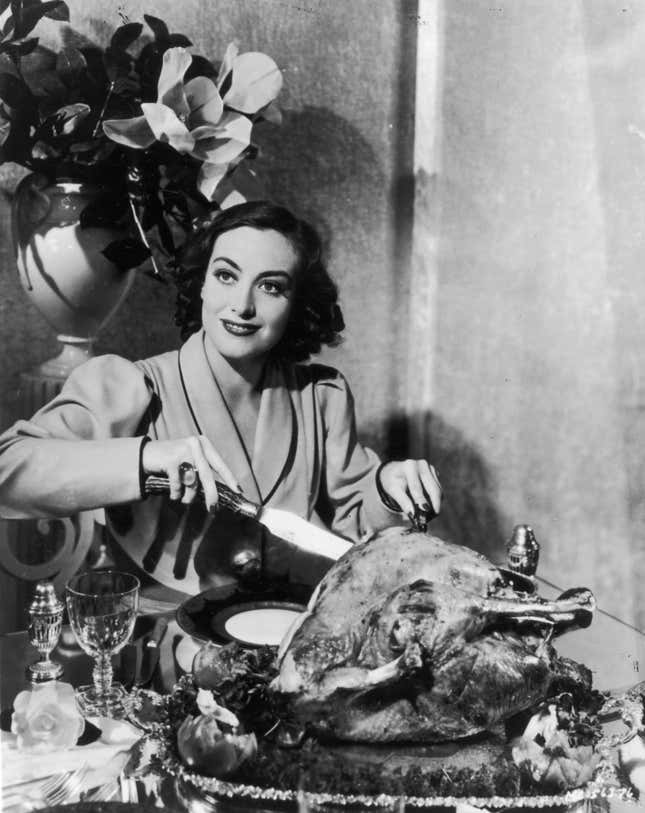
Farms where tourists can pick pumpkins and apples are places where, as Ott writes, “many Americans experience traditions that tie them to the past, to nature, and to each other.” But autumnal agritourism, such as casually strolling through a fruit orchard to pick a few apples, is an activity only tied consigned to the past if you are a wealthy urbanite. To visit a farm and pick a few apples is a way for white-collar city dwellers to play-act a pastoral fantasy, an aesthetic that’s also popped up in Fixer Upper-approved “modern farmhouse” design trends and often misleading, green-washed “farm-to-table” food branding. Agritourism supports a farm fantasy only intensified via social media, where farms are like set pieces for romantic photoshoot, totally removed from their labor intensive reality. Most commercial fruit picking in America is done by immigrants, many of whom are undocumented and afforded little to no protection. For many Americans, spending hours laboring in a fruit orchard is a daily reality, not a tourist attraction. “We’re picking, and they come out to have this experience, but we become part of the zoo,” Keri Wilson, who works on her family’s Washington 125-year-old apple farm told The Atlantic about tourists. “They look at you as if you’re … under the microscope.”
Play-acting a pastoral fantasy, one bound up in nostalgia for supposedly simpler times where families cultivated and lived off the land, was the foundation for Martha Stewart’s empire as a lifestyle icon. When Martha Stewart Living debuted in 1990, Stewart’s enthusiasm for fall decor further elevated holidays like Halloween and Thanksgiving to the heights of a blow-out like Christmas, but she also normalized the idea of fall decor to celebrate the season itself by treating pumpkins and corn husk wreaths like decorations.
Stewart, like other entertainers at the time who parlayed their expertise in dining and decoration into full-blown careers, ushered in a celebration of rustic domesticity from growing food to baking perfectly from scratch for the masses. But it was also an approach defined by Stewart’s whiteness and connection to an all-American ideal. “From the tiniest hors d’oeuvres to the catered weddings for two hundred, Martha Stewart food is whiteness with a high-church, White Anglo-Saxon Protestant (WASP) gloss,” Amy Bentley writes in “Martha’s Food: Whiteness of a Certain Kind,” noting that when “ethnic” dishes do appear in her cooking they are “absent any real trace of ethnicity.” And all that artisanal food production that stresses self-reliance (for example: growing, drying, grounding, baking with your own herbs) is actually only available to a small few. “To achieve the simplicity of bygone days, then, often requires enormous expenditures of time, money, and resources,” Bentley writes.
It’s that romanticization of the domestic simplicity of the past that fueled another product that merged white women and autumn in pop culture. The WB show Gilmore Girls, which premiered in 2000, grounds much of its aesthetic and mythology in a vaguely New England fall setting. From the autumn foliage in the show’s opening credits, to the celebration of the Autumn Festival, to an episode in which Lorelai must attend four (four!) Thanksgiving meals in one day, and Lorelai’s ability to literally smell winter’s forthcoming snow, autumn plays a big role in establishing Stars Hollow’s wholesome aura. Its sequel Gilmore Girls: A Year in the Life aired right after Thanksgiving in 2016, with another broadcast set to air Thanksgiving of this year. In the show, fall consumes the town regardless of an attached holiday, the town’s street posts and central gazebo covered in pumpkins and fake fall leaves.
But there’s more to Gilmore Girls’ New England romanticism at work beyond celebrating the changing seasons. Just as partaking in the autumn rituals transports modern Americans into the past, so does spending a lot of time in Stars Hollow. As Alyson R. Buckman writes in Screwball Television: Critical Perspectives on Gilmore Girls, the show’s small-town charm is rooted in an American dream defined by New England history. Through its depiction of a community that’s constantly watching its own members, not unlike the first established Puritan communities with a center square, and the town’s selling of history through antiques and tourist attractions, the show situates Stars Hollow “as a true place, one that is not only American but specifically New England.” The foundation of Stars Hollow is built on nostalgia for an older America, one notably autumnal, and one that is extremely white. “It is also a very racially constricted dream,” Buckman writes,“…reflected in the pervasive whiteness of Stars Hollow and the producers’ use of a few ethnic minorities as exotic ‘seasoning’ for an otherwise racially homogenous town.”
But nothing has tightened that connection between modern white women and romantic nostalgia for an agrarian life, while delivering a steady stream of autumn on demand, quite like the modern proliferation of pumpkin spice. While pumpkin spice as a spice made its official debut in the 1950s, it is the Starbucks pumpkin spice latte and its popularity among white women that really put the flavor on the map. Within a decade of its launch, the drink had racked up more than 200 million sales, the result of a brilliant marketing strategy that treated the drink as a big seasonal premiere.
A subsequent cottage industry of soaps, candles, baked goods, and more with the pumpkin spice flavor popped up and in 2013, Americans spent $308 million on pumpkin-flavored products. “There’s a culture of consumption in this ‘holiday’ season where you’re not just enjoying a Thanksgiving dinner one evening with your family, you have weeks of seasonal celebratory eating tied to the rise of pumpkin spice everything: air fresheners, candles, soaps, body scrubs,” Smithsonian food historian Ashley Rose Young tells Jezebel. “So often the target audience are these middle or upper-middle-class white women.”
In the early 2010s a certain famous, all-American white girl not only helped popularize the Starbucks pumpkin latte in the pages of tabloid magazines, but also delivered a pivotal pop album that would marry the fall season with songs of heartbreak and nostalgia at the exact moment the straw white girl who loves fall was becoming a meme. “My friends are so sick of me talking about autumn coming,” Taylor Swift told Esquire in 2014. With songs about relationships falling apart against the backdrop of “autumn leaves falling into place” and getting lost upstate, Swift’s 2012 album Red is largely considered a canonical fall album, one that would propel Swift out of country music and squarely into a mainstream pop arena. But the girl just loves fall in general; in 2014 she published a now-deleted “ode to fall” on her Tumblr (yes, Tumblr), featuring apple picking and fresh cider donuts. “…when the mornings are all chilly and you can see your breath and draw little pictures on foggy windows and plaid stuff and ankle boots and not caring when people make fun of pumpkin-flavored stuff cause you LOVE it and are happy. It’s all the rage,” she wrote.
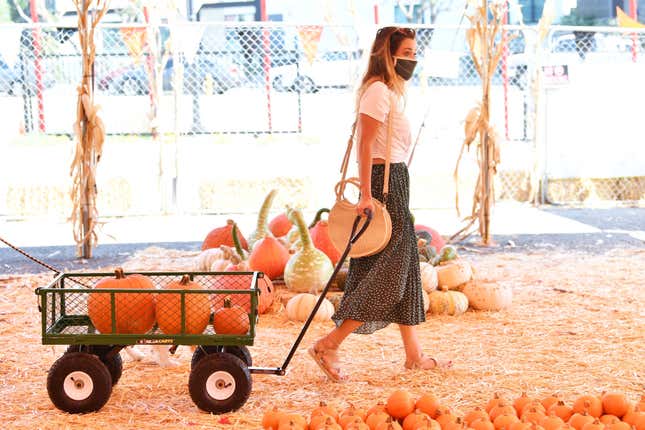
The pumpkin spice latte boom and Swift’s increased tabloid presence dovetailed with a very weird moment in internet culture. In the mid-2010s, it became quite trendy for dreadful listicle factories and blogs to identify and dissect all the things that make a “basic” white girl a “basic” white girl, shortened simply to “basic” or “basic bitches” or simply “bitches.” There were lists upon lists about why white girls love fall, thinkpiece after thinkpiece, and then responses to the thinkpieces and arguments about whether making fun of women for drinking pumpkin spice lattes is misogynistic. The snarkiest corners of the internet gathered around the proverbial campfire to debate the inherent basic-ness of white girls loving fall. It was exhausting.
While at this point it’s passé to debate the politics of a PSL, the connection between white girls and fall still thrives in meme culture. In 2019, Twitter user Nat @bimboification created the “Christian Girl Autumn” meme in the final dregs of Megan Thee Stallion’s “Hot Girl Summer,” randomly googling and attaching a photo of white women influencers looking wholesome in ripped jeans and scarves. “I think Christian girl autumn connected with so many people because we all know someone who dresses like that in our lives,” Nat told Jezebel over Twitter. “Some of us were even that girl! It’s just such a great joke to poke fun at seasonal cultures.”
But pointing at all of the activities and foods associated with fall in America and labeling them “white girl” things in 2020 doesn’t necessarily connote a hatred or disdain for them, despite what thinkpiece writers in 2013 might believe. It could just be that finally a culture long celebrated as being quintessentially American is now being labeled what it so often really is. “By naming it as ridiculous and naming it as problematic, it’s building an awareness of these contradicting ideas of what is American cuisine,” Young says in response to the associations regarding pumpkin spice. “For far too long it’s been defined through the lens of white people… By naming that as kind of other in a way, an othering of what was mainstream, you create more space to acknowledge the incredible diversity of American food cultures.”
The seasonal culture that has long defined American fall is a culture that seeks a connection to the country’s rustic past. It’s in how Sarah Josepha Hale lobbied white, upper-class women readers back to domesticity in planning a Thanksgiving feast, it’s in a Gilmore Girls rewatch that transports women viewers to a cozy, New England town in the thick of autumn, and it’s in a sip of a Starbucks pumpkin spice latte, a sugary, liquid replacement for partaking in the real produce grown on a quintessential American farm. It’s a largely white, Puritan past, one that celebrates old-fashioned family values that are the fiction of America’s past. But if everything white girls indulge in come autumn is basic, then so is the aesthetic and mythology of America’s past, one this country has cultivated and sold to the masses since Thanksgiving was invented.